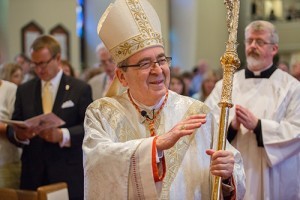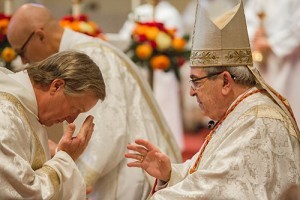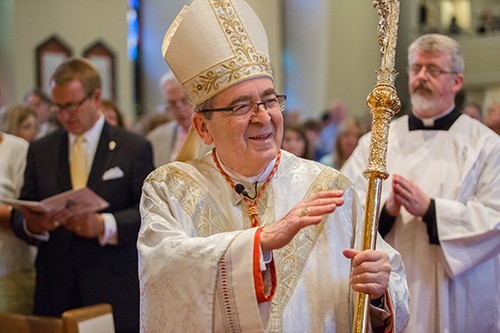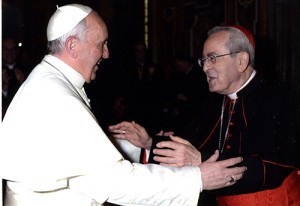
Cardinal Justin Rigali processes into Sacred Heart Cathedral, where he celebrated Mass on April 19.
Photo by Stephanie Richer
The walls and shelves in his Chancery office, crowded with photos, documents and items from some of the most heralded Church events in recent time, prove the point.
Vatican II, saints, popes, papal visits around the globe, papal conclaves — they’re all there.
So when the Diocese of Knoxville last month launched its most historic project since its founding 27 years ago, Cardinal Rigali’s presence was unmistakable.
To mark the cardinal’s 80th birthday on April 19, Bishop Richard F. Stika and a host of dignitaries — including the governor of Tennessee — broke ground on the diocese’s new Sacred Heart Cathedral.
As Cardinal Rigali celebrates his eighth decade, a milestone for princes of the Catholic Church, he reflected on his long and illustrious career serving the Church around the world.
“It’s a big birthday for anybody, but what is significant about the 80th birthday of a cardinal is that it marks a turning point in their service to the Church because the rules for the Cardinalate foresee that at 80 a cardinal remains a cardinal, but he no longer votes in any election that he might still live to see,” he said. “Also at the age of 80, he’s no longer a member of the different congregations in Rome. So it’s significant.”

Cardinal Justin Rigali gives Deacon David Lucheon a blessing during Mass on April 19 at Sacred Heart Cathedral.
Photo by Stephanie Richer
Justin Rigali’s history dates to 1935 in Los Angeles. Growing up in a devout Catholic family, he wasn’t attracted to the entertainment mecca that Los Angeles was becoming. Instead, the youngest of seven children was drawn to the seminary and in 1961 was ordained a priest. The family environment had a profound – and lasting – impact on the young Catholic.
“Well, I was blessed. God gave me wonderful parents. He gave me a very happy family and brothers and sisters I grew up with. We went to Catholic schools. I had a good education in the family, a good education in the Catholic schools, and so that in itself was conducive to living the faith and the example,” said Cardinal Rigali, who noted with appreciation that he was never under pressure to become a priest.
As a boy, routine interaction with men of the cloth sowed the seeds of discernment that wouldn’t be apparent for years to come.
“The Catholic priest was what inspired everything. It inspired our family. It inspired our lives together in the family, and it was what led us to make all the choices in our life because the faith is the teaching of Jesus, and that is what guides us through life at every stage from the time we’re young,” he said.
Religious role models left an impression, not only on Cardinal Rigali, but on his older siblings, one of whom accepted a religious vocation in the Sisters of St. Joseph and a brother who became a Jesuit priest.
“I think I was like every young man that goes into the priesthood. You’re attracted to the priesthood for what it is. By the grace of God, you’re attracted. You’ve probably been impressed by the example of some very holy priests, some very joyful priests, probably a young priest that gave you a good example of what the priesthood was all about in the service of God’s people,” he said.

Cardinal Justin Rigali is engaged in conversation at a reception on April 18 at the Tennessee Theatre.
Photo by Stephanie Richer
After seminary, young Father Rigali was sent to Rome for further studies in canon law. He did not expect to have a front seat to history so early in his priesthood. But while getting a doctorate in canon law, he was asked to be a priest assistant in the Second Vatican Council that St. John XXIII convoked on Oct. 11, 1962 – the first such council in nearly 100 years.
The young Father Rigali served during two of the four sessions of Vatican II, and as a priest assistant he was assigned to one of the sections in St. Peter’s Basilica where bishops and cardinals participating in the Church’s 21st ecumenical council sat. Bishop Fulton Sheen was among the prelates in Cardinal Rigali’s section. St. John XXIII opened Vatican II but died before its conclusion. Blessed Paul VI served as pope during the council’s conclusion. Vatican II is considered by many to be the most significant event in the Catholic Church in modern history.
“I was very privileged to be able to serve at the Second Vatican Council, and it was a great thrill. I was present every day of the session in 1962 and again in 1963,” Cardinal Rigali recalled. “The first two years were an extraordinary experience and a wonderful, wonderful participation in the council.”
Other two-month sessions in 1964 and 1965 were held before the council concluded. By the fall of 1964, Cardinal Rigali had completed his graduate studies and was working in the Vatican Secretariat of State, the oldest dicastery, or department, in the Vatican.
The profound effect Vatican II had on the world Church and Cardinal Rigali prompted him to author a book in 2006, entitled “Reliving Vatican II – It’s All About Jesus Christ.”
Recalling those heady days of his early priesthood, the cardinal said he probably did not realize at the time how historic Vatican II was.
“The documents still today have this extraordinary power to them because when you read them it’s like reading the Scriptures. Every time you read the sacred Scriptures, there’s something new, there’s something dynamic that emerges. It’s the same way with the Second Vatican Council documents,” he said.
As he completed his doctorate in canon law, Cardinal Rigali was pressed into service with the Secretariat of State, which performs political and diplomatic functions of the Holy See. Two more years of studies at the Pontifical Ecclesiastical Academy in Rome, from 1964 to 1966, prepared him for a role in foreign service for the Vatican – and, in turn, led him to work directly with Pope Paul VI.
After having been in Rome for five years, the Vatican assigned Cardinal Rigali in 1966 to Madagascar off the east coast of Africa, an island twice the size of Italy, where for three years he was Secretary of the Apostolic Nunciature, also known as a Vatican embassy. He then returned to Rome in 1970, where he served in the Vatican for the next 25 years.
He received his episcopal consecration from St. John Paul II in 1985, the same year he was appointed president of the Pontifical Ecclesiastical Academy. While in Rome for a quarter century, St. John Paul II named Cardinal Rigali to several high-ranking positions within the Roman Curia, including director of the English Language Department in the Secretariat of State as well as secretary of the Congregation for Bishops, the department that oversees selection of new bishops, and secretary of the College of Cardinals.
Those experiences were invaluable to the cardinal, who was in a position to serve for more than eight years as Blessed Paul VI’s English-language translator and then served Pope John Paul I during his historically brief 33-day papacy.“I was in Rome under four popes, and three of them I served very, very closely. One of them, the first one, Paul VI, I served eight and half years. The next one was 33 days. The next one was many years with Pope John Paul II. I was close to these popes because I had the opportunity to work with them. But Pope Paul VI, I was with him sometimes every day, sometimes more than once a day. With John Paul I, I was with him on various occasions, and I was the last person to go out of his office the day he died,” Cardinal Rigali said.
One memory that stands out for Cardinal Rigali is when he worked for Blessed Paul VI at a time when the cardinal’s brother, Paul Rigali, was seriously ill.
“He wished to go over something pertaining to the work of the office, desiring to check on the English to make sure he understood the exact meaning of the words so there would be no misunderstanding. At the end I said, ‘Goodnight, Holy Father.’ And he stopped me. He said to me, ‘How is Paul?’ I had asked him previously to pray for my brother, Paul. He was the father of 12 children, and he was dying of cancer,” Cardinal Rigali recalled. “He had four questions: ‘How was Paul doing? How was his wife holding up? How were the children? And ‘what can I do?’
It was incredible how personable he was and how interested in the individual he was. He had a billion Catholics to be concerned with, but he still had time to be concerned with one – how was Paul?”
The Holy Father then offered Mass for Paul two weeks later when he died.
Cardinal Rigali remembered working in close quarters with St. John Paul II. He served as the director of the English language section of the papal Secretariat for a number of years and often traveled with the pontiff. “And so I would be with St. John Paul II in different countries, on the airplane, and at meals, and he would often discuss work with me. It was extraordinary,” he noted.
Cardinal Rigali’s service to saints wasn’t limited to the papacy. He fondly recalls his encounters with Mother Teresa of Calcutta at the Vatican and elsewhere.
One conversation with Blessed Teresa that left an impression on the cardinal was when they were at a Vatican event waiting to speak to a large audience. Anticipating going out on stage with Blessed Teresa, he recalled that she was very calm. And as she was being introduced, Cardinal Rigali asked her what she would speak about, to which she replied, “Oh, I don’t know. All I know is that I will be speaking about Jesus.”
Pointing out that he did not serve St. John XXIII directly, but was present in Rome during his papacy, Cardinal Rigali said the three popes he did serve were his favorites, offering detailed insight into each one.
One poignant, private conversation between Cardinal Rigali and St. John Paul II occurred after the pope had met with Mehmet Ali Agca, who shot the pope four times in St. Peter’s Square in May 1981 in an assassination attempt, critically wounding the pontiff. The pope asked people to pray for Mr. Agca and later met with the shooter in prison. Although the pope had publicly forgiven Mr. Agca, St. John Paul II confided in Cardinal Rigali that during the historic prison visit, Mr. Agca’s only question to the pontiff was, “Why didn’t you die?”
After decades of service abroad, the pope designated Cardinal Rigali for assignment in another “Rome.” On Jan. 25, 1994, St. John Paul II named then-Archbishop Rigali the seventh archbishop of St. Louis, often referred to as the “Rome of the West.”
St. Louis is where then-Archbishop Rigali first met a young priest, Father Richard F. Stika, who served from 1993 to 2004 as the archbishop’s secretary and later as chancellor and vicar general.
Cardinal Rigali’s longtime close relationship with St. John Paul II prompted a papal visit to St. Louis in 1999, his only visit to a single U.S. diocese during his papacy. Then-Monsignor Stika coordinated the pope’s visit to St. Louis for the archdiocese.
The close working relationship between Cardinal Rigali and Bishop Stika continued after the cardinal was appointed by St. John Paul II as the eighth archbishop of Philadelphia in 2003 and has grown since Cardinal Rigali retired as Archbishop Emeritus of Philadelphia in 2011 after he turned 75 in 2010. While continuing Church duties in Rome, Cardinal Rigali reunited with Bishop Stika in Knoxville, where the cardinal has been in residence since leaving Philadelphia.
Bishop Stika, who was appointed the third bishop of Knoxville in January 2009 by Pope Benedict XVI and received his episcopal consecration on March 19, 2009, sees his mentor and close friend as Church history personified.
“He witnessed two sessions of Vatican II; he was actually at the Council. He worked intimately with Blessed Paul VI, John Paul I and St. John Paul II as well as Benedict XVI and Francis. He is living history.
He has witnessed extraordinary events in the history of the Church, and he has been involved in two papal elections,” Bishop Stika said. The bishop noted that Cardinal Rigali’s Church duties have run the gamut from working with heads of state to serving sick children and adults in hospitals.
“He has met saints and sinners,” Bishop Stika added.
The bishop fondly recalls first working with Cardinal Rigali once the cardinal was installed as St. Louis’ archbishop in March 1994. It was to be a learning experience for both the Church veteran and the younger St. Louis native.
“My role in St. Louis was to help him adapt from a life working in the Vatican to be an Ordinary – an archbishop. I know St. Louis quite well, so I was able to teach him, I hope, what life was like in St. Louis,” Bishop Stika said. “He was able to open my eyes to what it means to belong to the universal Church.”
Bishop Stika’s early influences on Cardinal Rigali occasionally went beyond the Church.
“I took him to his first Cardinals baseball game, and I was with him when he sampled his first White Castle. That’s what I taught him,” the bishop said with a broad smile.
What began as a working relationship in the Archdiocese of St. Louis grew into a close bond as they leaned on each other for their respective talents and gifts. The friendship even extended to Bishop Stika’s family, with his young nieces and nephews referring to the cardinal as “Uncle Archbishop.”
Distance didn’t diminish their closeness once His Eminence was named archbishop of Philadelphia and Father Stika became Bishop Stika. While Bishop Stika and Cardinal Rigali now share a diocesan residence in Knoxville, Cardinal Rigali continues to serve in the College of Cardinals and in an assignment for the Vatican.
Their bond was affirmed in the early morning hours of March 24. Bishop Stika had endured a stomach virus the day before, which led to a medical emergency. About 4:15 in the morning, the bishop woke Cardinal
Rigali, saying he was having trouble breathing. His Eminence phoned 911, and the bishop was rushed to a hospital and was treated for diabetic ketoacidosis. At one point, he had been given a 10 percent chance of survival.
Bishop Stika credits Cardinal Rigali for saving his life.
“In these last weeks, if he had not been living with me I would not have survived the night,” Bishop Stika said. “To me, he’s a father figure. I was blessed with my own father, Frank Stika. But next to my dad, the cardinal has become over these 21 years a true father to me.”
While he is admired and respected from Los Angeles to Rome, Cardinal Rigali counts among his close friends Cardinal Levada and Cardinal Timothy Dolan, archbishop of New York and former president of the U.S. Conference of Catholic Bishops. Cardinal Levada succeeded Cardinal Joseph Ratzinger as Prefect of the Congregation for the Doctrine of Faith when Cardinal Ratzinger became Pope Benedict XVI. Cardinal Levada served in that role from May 2005 until June 2012, when he reached the age of 75.
“I have known Cardinal Rigali since I first entered the seminary, my first year of college. He was in his second year of college, and we struck up a great friendship that has lasted all these many, many years. We had the good fortune in several of our assignments in Rome to have worked together, so over the years we have had a chance to get together frequently and take each other out to dinner and talk over the theological and philosophical problems of the world and the Church,” Cardinal Levada said.
“So I am particularly excited to be here to celebrate his 80th birthday with him in the context of this beautiful groundbreaking ceremony for the new cathedral church of the Diocese of Knoxville. There’s a great sense of the enthusiasm people here have looking to the future. So we hope and pray for a future for Cardinal Rigali for as long as our Lord wants,” Cardinal Levada added.
Cardinal Rigali marked his 80th birthday by celebrating Mass at the Cathedral of the Sacred Heart of Jesus just before ground was broken outside for the new cathedral building. He delivered his homily and distributed Communion with Cardinals Dolan and Levada to an overflow congregation. Many parishioners had to watch Mass via video screen from the Sacred Heart School gymnasium.As his birthday was acknowledged, Cardinal Rigali received a standing ovation from those attending Mass as his brother cardinals smiled and watched.
Cardinal Dolan has been watching with interest since he was in seminary in Rome in the early 1970s and Cardinal Rigali was serving Blessed Paul VI. They were later reunited in St. Louis.
“I used to admire him just as a hard-working priest in service to the Holy See, then I got to know him as a high-ranking Vatican official and my admiration increased. Then I got to know him as my own archbishop, so there was a wonderful filial affection,” Cardinal Dolan said. “Then I got to know him as a brother bishop, so that admiration and affection was intensified. We’ve just stayed close. I don’t think two or three days would go by that we wouldn’t talk. We try to get together as much as possible. His counsel is unfailingly right on target and I just appreciate him very much.”
Cardinal Dolan has been impressed by Cardinal Rigali’s spiritual sense as well as his leadership roles in the Vatican. Despite those high-level positions, Cardinal Dolan has found the senior cardinal warm and welcoming – and inclusive.
The New York archbishop likes to remember when he received his episcopal consecration from Cardinal Rigali on Aug. 15, 2001, in St. Louis.
“As we were going out, he said, ‘Tim, you can take tomorrow off,’ which was the only free day I got when I worked for him. That was his idea of a gift – a day off,” Cardinal Dolan, said laughing. “But I loved that year, and it was great schooling for me on how to be a good shepherd. … I never lost touch and I admire him immensely.”
Taking a more serious tone, Cardinal Dolan recalled becoming Cardinal Rigali’s auxiliary bishop in St. Louis during the height of the sexual-abuse scandal.
“That was a tough year,” Cardinal Dolan said. “It was a daily crucifixion, and yet I will never forget the intensity of his faith, the professionalism of his work, the sensitivity he had toward those who were suffering – the victims, yes; families, yes; the Church in general, yes; the priests, yes. I was always amazed how he would never panic. He wouldn’t lose his cool. He would always resort to prayer, and he was just a very sound and wise leader whom I respected very much.”
That wisdom comes from over five decades of experience at the highest levels of the Church during some of the most historic years in the modern Church era, experience that has served Cardinal Rigali well.
Constancy in delivering the message of Jesus Christ throughout the universal Church in good times and bad is one of the key challenges facing Catholicism, according to Cardinal Rigali. He said adapting the message, not changing it, is vital in reaching people globally.
“The Church is involved in every situation of good and evil. She’s there with every situation of good to encourage and try and promote it, and the evil to try and restrain it with the Word of God. It’s one challenge after another,” Cardinal Rigali observed. “It’s the challenge of all the different evils that affect the Church. And it’s the challenge of all the different situations in which the Church must continue to proclaim the Gospel with constancy, with love, with perseverance. One of the headlines that we need is “Peace in the World” and peace beginning in your families; peace beginning in hearts; peace in nations; racial justice; people getting along with one another. This is the world.”
As he reflects on a lifetime of service to the Roman Catholic Church, Cardinal Rigali acknowledged that he never had designs on positions other than being a parish priest – and that presuming to become a bishop, archbishop, cardinal, or pope is counter to carrying out the message of Jesus Christ. He said he accepted every assignment with joy and a determination to serve the Holy Spirit through the Church and has been very blessed to have served in different roles.
But those roles all lead back to the parishes.
“The whole purpose of the Vatican, the Holy See, the pope and all those who worked with him exists in order to assist the Church throughout the world. Everything that the pope does and all the services his office offers, it’s all to reinforce Christianity as it’s being lived on the grassroots level. That’s what the Church is all about,” he said.
But Cardinal Rigali does believe that among his most important acts for the Church are helping to select popes in two papal conclaves. Among those acknowledging his 80th birthday was Pope Francis, who presented Cardinal Rigali with a formal birthday greeting, including a signed personal note and an apostolic blessing.
Going forward, Cardinal Rigali intends to carry out his duties as a Cardinal, serve the Vatican on a committee he still is assigned to, and serve the Church in East Tennessee.
“I will try to live each day as long as God gives me life. My plans are to continue in the service that I am in here. I’m very happy to have the hospitality of Bishop Stika and to be welcomed in the Diocese of Knoxville and to be of help here in different ways,” he said.
And as far as his legacy goes, it is rather simple.
“Just to be faithful to the Gospel, to be faithful to Christ, be faithful to the priesthood and my vocation, and to have done what the Lord asked me to do in the context of the Church. In other words, contribute according to my calling, my vocation. And contribute to the work of the Church, which is the proclamation of the Gospel,” he said.
That vocation is a living lesson into the history of the universal Catholic Church. And the education continues.
Nearly 1,200 people who attended A Conversation with the Cardinals April 18 at the Tennessee Theatre, with Cardinals Rigali, Dolan and Levada sharing their stories, saw history come alive – in captivating detail.
Bishop Stika, who emceed the event, wants to make sure that as many people as possible – from laity to men and women religious – benefit from Cardinal Rigali’s vocation.
“The lesson I think he has given to me is total service to the Church, because that is what he has lived,” Bishop Stika said. “I have witnessed him interacting with Popes John Paul II, Benedict and Francis, and with President George W. Bush and President Clinton. And I’ve also seen him work with the poorest of the poor in Bolivia and in the United States, visiting people in hospitals. I so often say that we should be the face of Jesus. I’ve seen him time and time and time again living that out. He’s a very kind man. He’s a very prayerful man. It’s hard to show all his charity and goodness. To me, he’s a priest’s priest.”



